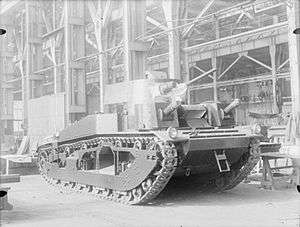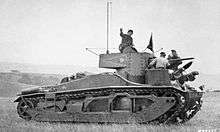Medium Mark III
| Medium Mk III | |
|---|---|
 | |
| Type | Medium tank |
| Place of origin |
|
| Service history | |
| Used by | British Army |
| Wars | none |
| Production history | |
| Designed | 1930 (A6 - 1926) |
| Manufacturer |
Vickers-Armstrong Royal Ordnance Factory |
| Number built | 3 |
| Specifications | |
| Weight | 16 tons |
| Length | 21 ft 6 in (6.55 m) |
| Width | 8 ft 9 in |
| Height | 9 ft 2 in |
| Crew | 7 |
|
| |
| Armour | 9-14 mm |
Main armament | 3 pounder gun |
Secondary armament | 3x 0.303 Vickers machine guns |
| Engine |
Armstrong Siddeley air-cooled V8 180 hp |
Operational range | 120 miles (190 km) |
| Speed | 30 mph (48 km/h) |
The Medium Mark III was a medium tank developed in the United Kingdom during the inter-war period. The tank was unsuccessful with only 3 built. The design did not directly derive from earlier Medium Mark II tank.
Development history
A6 "Sixteen tonners"
In 1926, the British War Office wanted to replace their existing Mark II tanks with a new design. In May the Royal Tank Corps Centre was asked for its opinion, which it submitted in July. One of the requirements was a weight limit of 15.5 tons, which led to the nickname "16-tonners". Other specifications included that it could transported by rail, a sufficient supply of lubrication oil to match the range of the tank (dictated by the fuel carried), a wireless set, a gun capable of defeating enemy armour at a range of at least a thousand yards, fuel tanks external to the main compartments and bottom armour sufficient to withstand heavy machine-gun fire when exposed while climbing a crest. Furthermore the machine should be as silent as possible, as with previous types the engine noise tended to incapacitate the crew.
The War Office added some extra requirements: a separate engine compartment; superior steering capacity and 13 millimetres frontal armour with 9 millimetres thickness for the other plates.
In September Vickers, given the order to build a prototype, proposed a first design based on the Vickers A1E1 Independent, with the fighting compartment in front and the engine compartment at the back. There would be a central two-man turret with a 3-pounder (47 mm) gun and a coaxial machine-gun; it was intended to house the commander and a special observer, each being provided a separate cupola. In the front of the hull were to be placed two secondary machine-gun turrets, each with a twin Vickers machine gun. A third machine-gun turret was intended to be mounted at the back of the vehicle, behind the main turret a, which would be armed with an anti-aircraft (AA) weapon. A crew of seven men was needed. Maximum armour would be 13 millimetres and basis armour 6.5 millimetres, limiting the weight to fourteen tons. Riveted plates were used. The total fuel supply would be 120 imp gal (550 l) gallons: ten in a small tank inside, gravity feeding the engine; the remainder in external tanks on the fenders. Two engine options were indicated: a 120 hp engine would allow for a speed of 14 mph and a 180 hp engine would raise this to 20 mph (32 km/h).
The result was called A6. In March 1927 a wooden mock-up was presented and after approval a second and prototype were ordered which had to incorporate the new hydraulically operated Wilson epicyclic steering gearbox, the predecessor of the Merrit-Brown gearbox. By June 1928 both prototypes (A6E1 and A6E2) were presented to the Mechanized Warfare Experimental Establishment for trials. Vickers was on this occasion ordered to add armour skirts but keep within the weight limit even if it meant removing armour elsewhere. Meanwhile, a third prototype had been ordered: A6E3.
A6E1, A6E2 and A6E3 were fitted with an Armstrong Siddeley air-cooled V8 180 hp engine giving a maximum speed of 26 mph. A6E2 was fitted with the Ricardo CI 180 hp engine but this was not satisfactory and the Armstrong-Siddeley refitted. A6E3 was later re-engined with the Thornycroft 6V 500 hp - a slow running marine engine. It was proposed to combine two Rolls-Royce Phantom engines with the Wilson transmission system on the A6E1, but in view of the costs this was rejected. A6E2 was eventually refitted with the AS V8 180 hp.
The guns were tested in July 1928. This proved that the twin-machine gun arrangement was unworkable; so the A6E3, then being constructed, was fitted with a simplified design with a single machine-gun; it also had single cupola on the centreline of the turret. The AA-turret was removed from A6E1. However it was also shown that the suspension and the gunnery arrangements were distinctly inferior to those of the Mark II. It was therefore decided to discontinue the development of the type and use the three vehicles merely as test-beds for the automotive parts. In 1929 Vickers submitted three alternative suspension designs, which were fitted to the respective prototypes; one of these, tried on A6E3, involved a fundamental reconstruction of the hull. None proved able to provide a stable gun platform. Only in 1934 a satisfactory type was fitted by a specialised firm.[1]
Medium Mark III

The disappointments in the A6 design led to a new design, the "Medium Mark III", being ordered in 1928 and constructed from 1930.[2] It was similar to the A6 design but featured a new turret and improved armour. The turret had a flat gun mantlet and a bulge at the back to hold the radio set. The secondary machine-gun turrets were moved more to the front to shift the centre of gravity of the entire vehicle forward to improve its stability. Larger brakes were fitted. In 1933 trials were completed of the first two prototypes. The type was reliable and provided a good gun platform. However, it still suffered from its bad suspension design: even though road speed increased to thirty miles per hour, during cross-country rides the bogies were often overloaded. Three Mark IIIs were built, one by Vickers and two by the Royal Ordnance Factory at Woolwich: Medium III E1, E2 and E3. The third had an improved suspension and the vehicles were in 1934 taken into use by the HQ of the Tank Brigade. However, no orders followed due to its high price; Medium III E2 was lost to a fire.
One of the Mark IIIs was fitted as a command vehicle with an extra radio aerial around the turret. This was used by Brigadier Percy Hobart for the Salisbury Plain exercises during 1934.[3]
Notes
References
| Wikimedia Commons has media related to Medium tank Mark III. |
- Duncan, N.W. (1973). Mediums Marks I-III. AFV in Profile No. 12. Windsor: Profile Publications.